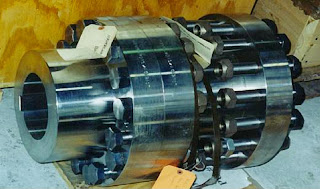 Universal joints (often called u-joints, Cardan joints dates back as far as 1545, when Italian mathematician Gerolamo Cardano first suggested using a universal joint for power transmission purposes. Today universal joints are found in countless applications and industries.
Universal joints (often called u-joints, Cardan joints dates back as far as 1545, when Italian mathematician Gerolamo Cardano first suggested using a universal joint for power transmission purposes. Today universal joints are found in countless applications and industries. Given universal joints impressive ability to handle angular misalignment (generally up to 25 degrees)... and their near ubiquitous use in some applications... some might wonder why other coupling solutions exist at all.
What exactly makes universal joints so "universal", and where do universal joints fall short?
Fantastic for Misalignment Handling
In general, shaft misalignment does not do good things for the life expectancy of any flexible coupling or joint (be it a universal joint or other designs), but, in many applications, large angular misalignment handling is unavoidable. For such applications, universal joints are often ideal.
Universal joints can also handle significant parallel misalignment needs by making use of two joints in series (as shown in the DD and DDX types at right).
Lastly, while not a standard feature, axial misalignment can also be handled with universal joints by adding an additional sliding shaft or spline feature to the joint assembly.
Primary Drawbacks of Universal Joints
#1. Space (Long Footprint)
Relative to other coupling solutions, universal joints do not have the most power dense design (i.e. - gear couplings), in particular, in regards to overall length/required distance between shaft ends. Assuming parallel misalignment must also be accommodated (in addition to angular), two joints in series must be used. Two joints are also needed if near constant velocity is required (see drawback #2 below).
#2. Speed Fluctuation
While many coupling types inherently provide constant velocity output (i.e. - disc couplings), a single universal joint, subject to angular misalignment, will not provide a variable output velocity. This velocity variation gets worse (larger) as the angular misalignment that joint sees... which can be a source of torsional vibration into a given power transmission system.
This drawback was first noticed and recorded by Robert Hooke between 1667 and 1675. Fortunately, Hook realized that the output fluctuation can be largely eliminated (turned into to a near constant velocity joint) by using 2 standard joints back to back (i.e. - DD and DDX type) where the center member's yoke ears are aligned (the two joints are 90 degrees out of phase) and joint angles are equal. This is because the second joint (being 90 degrees out of phase with the same angle) compensates/cancels out the velocity changes from the first joint. Such joints are often referred to as Double Cardan.
Note: In addition to the Double Cardan, where constant velocity is mission critical, there are several other unique constant velocity joints (often called cv-joints) available in the market. These designs tend to be significantly more complex/expensive, and may have a reduced load carrying capacity.
#3. No Dampening
Universal joints are generally not designed to dampen vibrations, inclusive of any torsional vibrations a given universal joint might introduce into a system (from output velocity fluctuation).
Depending on the application, the inability of a joint to dampen vibration may be viewed as a major weakness relative to other couplings designs. Many other designs are either inherently good at dampening vibrations (i.e. - elastomeric coupling types to include Jaw, S-Flex & metallic Grid couplings) and others are designed explicitly to dampen specific vibrations relative to a specific user application (i.e. - torsional couplings).
#4. Maintenance
Unlike many elastomeric and some metallic coupling designs, universal joints generally include lubricated metal on metal connections. As such, universal joints generally cannot be viewed as "maintenance-free". (Periodic inspection/re-lubrication is required, and the joint will still eventually wear out.) Indeed, a number of companies exist and thrive by servicing and rebuilding large high torque industrial universal joints.
Big Picture
Within the category of universal joints there is a wide breadth of product options. They include the following four subgroups.
Pin & Block designs (which encompass the majority of Lovejoy's product lineup - show above) are the fundamental "bread and butter" design. They are well-suited to work in the lower speed ranges (up to 1,750 rpm), and are able to transmit a fairly significant amount of torque relative to the outside diameter. These designs include a center block and two pins connecting the yokes to the block, and are readily available in several of grades of steel (inclusive of stainless). Lubrication and use of rubber boots around the joint is required for optimal/extended life of these designs.
Needle Bearing designs (also available by Lovejoy) operate at increased speeds (up to 6,000 rpm) and generally have reduced backlash, but are rated to carry a bit less torque (relative to Pin & Block). Needle Bearing universal joints generally come per-lubricated and sealed. Like Pin & Block, boots & lubrication are still required for optimal wear/system life.
Ball & Socket universal joints are another type (not offered by Lovejoy) that generally eliminate backlash, but at the expense of torque and speed.
Cross & Bearing universal joints replace the block and pins with a hardy single center "cross" member. These designs (not currently offered by Lovejoy) are generally seen on higher torque applications inclusive of large mobile equipment and industrial drive shafts.
If you are confident a universal joint is what you need for your given application... Lovejoy's universal joint product catalog is readily available for download, and your closest Lovejoy distributor can be found here.
Should you have any further questions or concerns regarding universal joints, please visiting Lovejoy's universal joint product page or contacting a Lovejoy product specialist.
And if you would like to explore other coupling solutions (outside of universal joints), please consider starting by reviewing Lovejoy's Coupling Preselection Guide and/or reading The Coupling Handbook.




